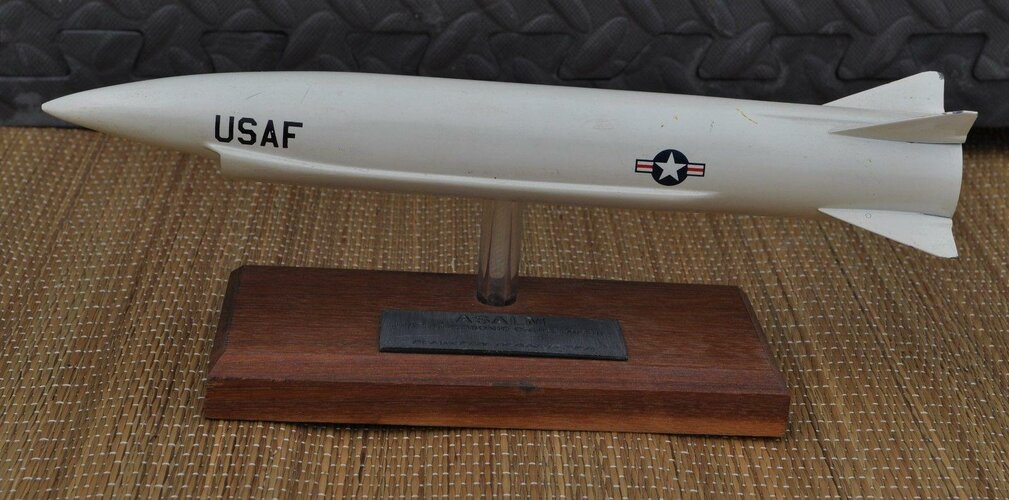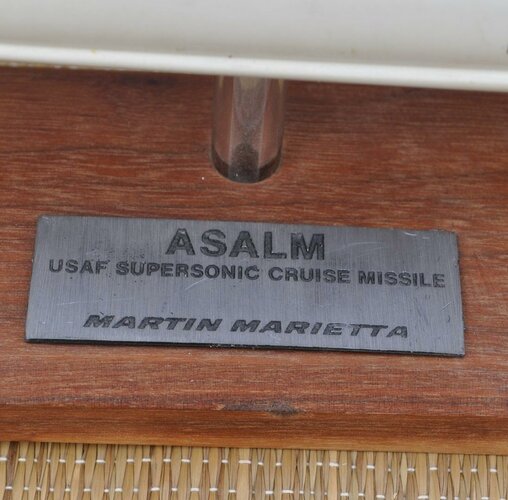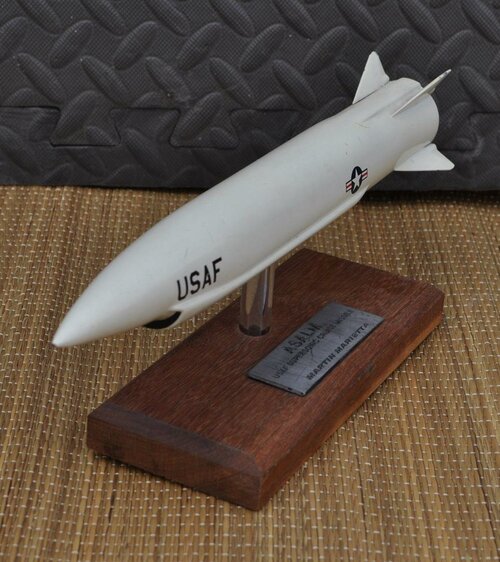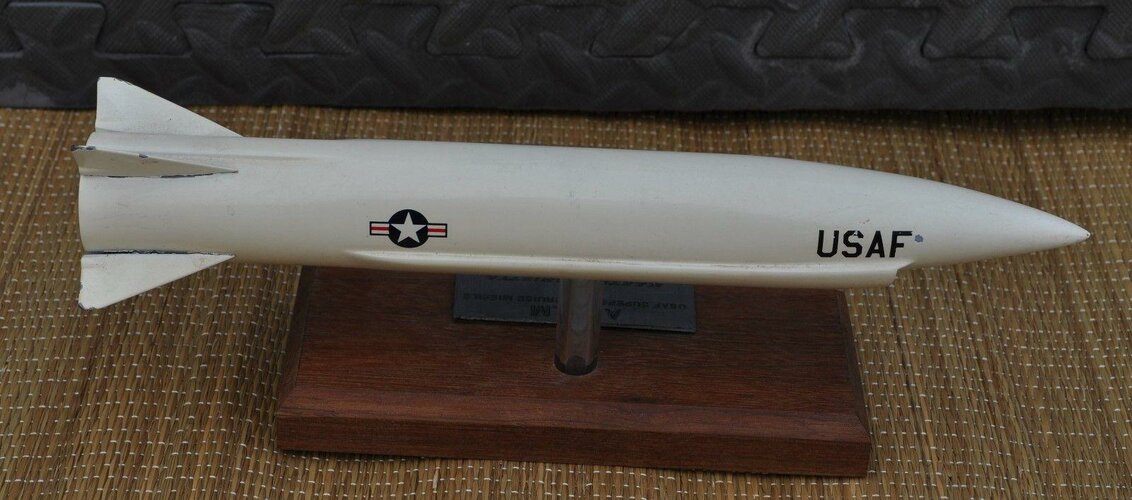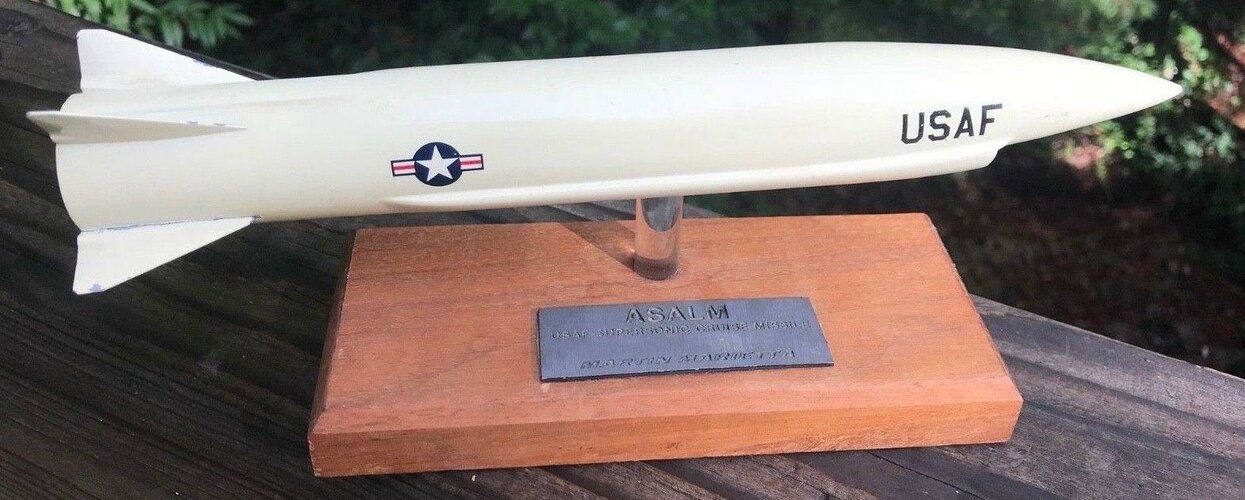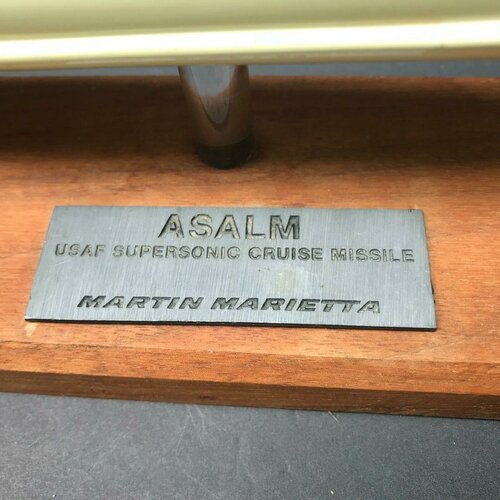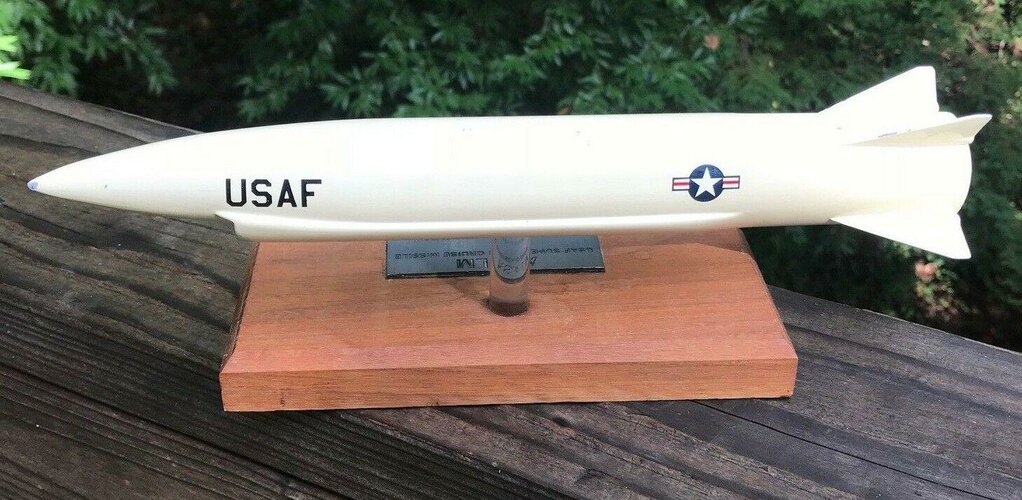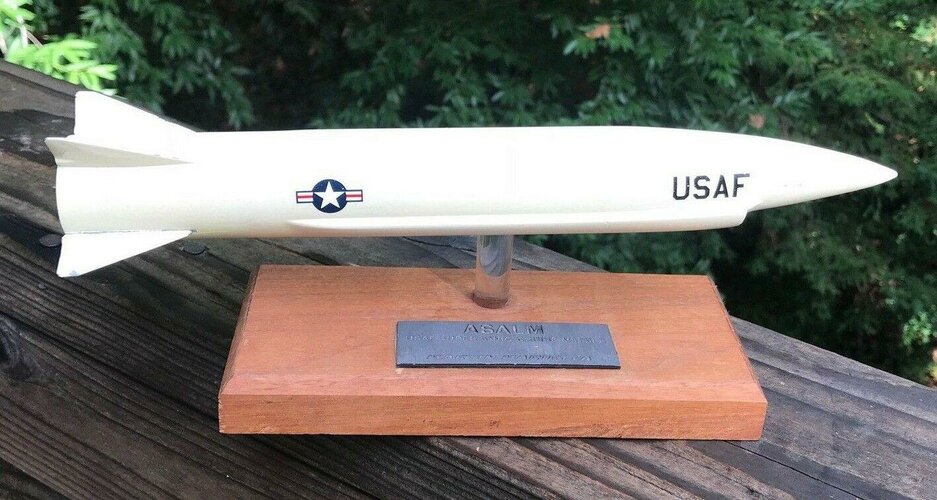sferrin said:
I'm wondering if maybe they were thinking about stealth aircraft dealing with SUAWACS instead.
I haven't read the whole article but it may help you.
Aviation Week & Space Technology
January 29, 1979
Advanced Bomber, Missile in Definition
BYLINE: By Craig Covault
SECTION: SPECIAL REPORT: US AIR FORCE; Research and Development: Changing Patterns; Pg. 113
LENGTH: 2808 words
DATELINE: Wright-Patterson AFB, Ohio
U.S. Air Force is in the earliest stages of defining a new strategic manned bomber and advanced technology cruise missile. Both could be operational by the early 1990s to replace the Boeing B-52 or cruise missile system currently under development.
About $15 million is being requested in Fiscal 1980 for the new bomber program.
Aeronautical Systems Div.hs advanced cruise missile study has been geared toward identifying key technologies for such weapons. But technology projections for the 1990s have proved difficult because potentially important subcontractors are concentrating on the near term and have provided little far-term enginneering development forecasts for incorporation into the USAF long-range planning, researchers here said.
Although strategic planners here see a serious need for early planning for an advanced survivable cruise missile carrier to go along with a new missile, Congress failed to provide funding for this technology work. Eingineers here foresee survivability problems with some of the current cruise missile carrier aircraft candidates because most of them have not been designed with strategic strike and survival in mind. The new manned bomber will be a factor in advanced cruise missile development.
The Rockwell International B-1 earlier terminated by President Jimmy Carter and the General Dynamics FB-111H reengined version of the operational FB-111A, both terrain-following bombers, will be considered along with more-advanced designs in the new manned bomber program.
Termination of the B-1 program in 1977 has not dampened USAF insistence that manned strategic bombers must be considered as strong candidates for the future. The course of the new manned bomber program will be strongly dependent on decisions made in the cruise missile carrier aircraft (CMCA) program, which Aeronautical Systems Div. planners view as a program competing for funds and manpower.
Basic questions on strategic attack aircraft are being reexamined under the new bomber program. These are:
* Penetration capability -- "We are seeing the standoff and penetration concepts coming closer together," according to USAF Capt. Milton Moores, ASD project manager for the conceptual phase of the new manned bomber program. The new bomber may be a merging of the two concepts, he said. Cruise missile carriers may have to be hardened more as the threat moves outward from enemy frontiers and attacking missiles are going to have to be placed in longer-range aircraft. "The word 'bomber' may be a misnomer because the aircraft will carry cruise missiles, whether it is designed 'hard' to penetrate [low] or designed to stand off at higher altitudes," Moores said.
* Penetration altitude -- There are indications USAF is considering a move away from today's low-level penetrator to an extremely high-altitude/high-speed bomber. "Some people in very high places talk about very high/very fast penetrators," Moores said.
Soviet threats are making bomber penetration of the USSR increasingly difficult. Computer war games conducted under the advanced cruise missile study here showed that with the projected 1995 air defense threat, penetration by B-1/B-52 type aircraft could result in loss of most of the bombers before they launched their advanced technology cruise missiles.
Use of B-1/B-52 type aircraft against a 1995 Soviet threat has inherent inaccuracies because by 1995 technology should have improved beyond the B-1/B-52 stage, but the computer analysis employed the most advanced electronic countermeasures and lethal bomber defense systems envisioned and still resulted in very high penetrator losses prior to cruise missile launch.
All potential bomber concepts will be studied during the early phases of the new bomber program. While extremely high and fast aircraft will be given consideration, recent advanced bomber studies show that once an aircraft is designed for speeds above Mach 1, its life-cycle and development costs climb dramatically. The studies show that supersonic speed, at least in a low-level environment, may not add commensurately more survivability when compared to bomber defense systems and low radar cross-section techniques that will increase survivability over today's capabilities in those areas.
Aeronautical Systems Div.'s deputy for development planning was asked by the USAF Air Staff in late 1978 to prepare a preliminary development plan for the new manned bomber.
This is in advance of the formal USAF new manned bomber mission element needs statement planned soon and a USAF program management directive which will give formal approval for the development effot. Studies that will be used by USAF to draft the new mission element needs statement and will be used as key early guides to the program are:
* Innovative strategic aircraft design study -- This effort was conducted originally by Boeing and Rockwell International to identify possible bomber designs that could be follow-ons to the B-1 once it entered service. The basic data will be useful in the initial new manned bomber work, even though innovative strategic aircraft design studies (ISADS) concepts may be too advanced technically for the current project. The ISADS concepts were geared to a B-1 replacement, but the current new bomber project is oriented toward a B-52 replacement. This makes the ISADs data somewhat too advanced for the current project.
* Strategic bomber study -- Performed by General Research Corp. of Santa Barbara. Calif., for the Office of the Secretary of Defense, the study evaluated the B-1, FB-111H, the effect of extensive B-52 modifications and the potential for new bomber designs to identify weaknesses and possible options for the future. One conclusion reached was that an FB-111H model would be an extremely expensive way to proceed. The General Research Corp. study is a major input to the mission element needs statement.
* Strategic Air Command requirement for operational capability -- Also known as a statement of operational need, this document is just being completed by SAC and will support development of a new manned bomber.
* New manned bomber requirements study -- This is a joint SAC/ASD project that will examine the technical requirements for a new aircraft. First results from this effort are expected in late 1979 and will spell out deficiencies that must be addressed in future systems.
* Strategic bomber enhancement program -- This is a group of related efforts that together will be used to assess the status of technology related to strategic systems. It will not only address bombers from an airframe standpoint, but also areas such as cruise missile avionics that can affect attack planning for this leg of the triad.
ASD will use funds in Fiscal 1979 planned for general strategic work to initiate the new manned bomber program since the new program element, designated 63251F, has no designated Fiscal 1979 funds. Money to evaluate alternative concepts will be requested in Fiscal 1980.
Concept Timetable
First Defense System Acquisition Review Council meeting on the project could select the new manned bomber concepts in Fiscal 1981. A systems program office then would contract for a demonstration validation phase that could run through Fiscal 1984, with a full-scale engineering development program starting possibly as early as Fiscal 1985, leading to possible production of an operational aircraft in about 1988.
Generally, it is believed a new bomber would have to have electronics hardened at least to the B-1 level and require electronic countermeasures and active defensive systems such as gunds or missiles, no matter how much progress is made in radar cross-section reduction.
The biggest technology area will be radar cross-section reduction from both a materails and structures standpoint.
The innovative strategic aircraft design study considered many innovative concepts that will be examined for application to the new manned bomber. These include forward-swept wing and flying-wing span loader designs, as well as ground effects machines. Nuclear propulsion and laser defensive systems also were identified but not viewed as likely for application to the new manned bomber program.
Rockwell supplied USAF with five possible new bomber concepts in the innovative strategic aircraft study and Boeing supplied six. No one in USAF or the contractors believes the designs or costs estimated for the designs are anything but extremely preliminary ideas on what could be designed 10-15 years from now. The designs or costs are not going to be directly transferable to the new bomber program because the program is keyed to a more near-term aircraft than the study considered.They do offer a starting point to work from, however, and are useful from the standpoint of showing what engineers believe could evolve.
The contractors submitted several versions of the flying wing or span loader. Life-cycle costs roughly estimated for these span loader designs were among the lowest for all the aircraft emerging from the study.
The $12-13.6 billion range in life-cycle costs for these aircraft spread over 15-20 years were lower than other designs because span loaders have relatively simple structures in which the entire simple structures in which the entire aircraft is an airfoil. The basic flying wing carries a 50,000-lb, payload, the same as the B-1. Two other possible span loader versions showed extremely low radar cross-sections and possible laser defense systems.
The aircraft would hae short takeoff capability. The ride in the low-level environment could be a problem because of aerodynamic characteristics. Advanced active controls now available could be applied to prevent stability problems that earlier flying wings encountered.
Boeing also investigated turboprops, but analysis showed that the extensive moving parts required raised costs. Radar cross-section also was increased by turboprop propulsion.
This study dictated that all aircraft concepts had to be able to fly unrefueled strike missions into Soviet territory from U.S. bases. The new manned bomber program now under way, however, would use tankers.
A more near-term conventional design created by Boeing was an aircraft about 50% the size of a B-52, which would use two moderate-bypass-ratio engines for subsonic cruise and attack from low-level, terrain-following flight. This design also had a 25:1 thrust-to-weight ratio engine in the rear that would be used for takeoff and landing only.
Both contractors' supersonic concepts were swing-wing designs with a life-cycle cost of almost $20 billion or about $6 billion more than the most expensive subsonic concept.
Rockwell pursued only one span loader flying concept and concentrated on low radar cross-section as this concept's key advantage. A laser-defended delta-wing vehicle that would use two dimensional engine nozzles for thrust control was considered a possible design, as was a double delta design described as having minimum weight characteristics.
A low-cost, high-performance penetrator with forward-swept wings and canards was another Rockwell concept. Rockwell International and Grumman have been doing considerable design work on forward-sweep concepts for the Defense Advanced Research Projects Agency, the National Aeronautics and Space Administration and USAF to simplify overall aircraft manufacturing by allowing a constant chord wing and canard.
Engine technologies for an advanced cruise missile are an entirely different story. Powerplant technology must make significant strides to achieve the performance desired for these weapons.
Advanced cruise missile airframe studies have been performed by Boeing, McDonnell douglas and General Dynamics/Convair. A mission analysis phase of the study effort has been conducted by Martin Marietta and Rockwell International.
The studies involved strategic strike situations for 1995-2000 and evaluated the availability of technology in 1990-1995.It is possible, however, that advanced cruise missile development and production could be started somewhat earlier than these study dates imply, according to Richard R. Stalder, who manages advanced cruise missile studies for ASD's strategic planning directorate.
Primary missions evaluated were prime strategic strike, defense suppression and anti-airborne warning and control system for an air-to-air version of the vehicle. Four specific performance regions were studied from the standpoint of both low-and high-altitude attack. These are.
* Subsonic cruise missile powered by a turbofan engine.
* Subsonic cruise/Supersonic dash missile powered by a duct-burning turbofan or turboramjet.
* Supersonic cruise missile powered by a turbojet or integral rocket ramjet.
* Hypersonic cruise missile flying at Mach 6 at altitudes of 150,000-200,000 ft. and powered by a supersonic combustion ramjet better known as a scramjet.
Bulk of the highly secret studies were completed last month, although the three contracts have been extended for studies for an additional six months on the most promising concepts.
Each of the three contractors has derived 30-40 possible cruise missile configurations, which are now being sifted to find the most viable designs for potential missions.
Ranges of 700 mi. to 2,800 mi. have been evaluated because it is uncertain whether the aircraft that will carry these weapons would be penetrators or launch the missiles from a standoff position.
Ability of cruise missiles to perform other roles, such as electronic countermeasures and reconnaissance, also was evaluated.
An extensive amount of threat and performance analysis has been done on the configurations to decide what concepts should be pursued further.
Threat projections, mission analysis and technology projections all have been applied in reaching initial configuration. This process then has been followed by a one-on-one threat analysis and overall engagement analysis to identify critical technologies that ASD will recommend USAF pursue starting with the Fiscal 1980 budget, the first year the advanced technology cruise missile will have a dedicated project office here in Dayton.
Key technologies that have been identified are the following:
* Stealth technology.
* Engines and fuels.
* Avionics.
"Stealth cannot be overemphasized," Stalder said. "Those technologies are really not here today so there are going to have to be a lot of research dollars put into them."
Propulsion Crucial
Propulsion would be "the long pole in the tent" if USAF decides to develop an advanced cruise missile for earlier than the mid-1990s, which is possible, Stalder said.
To get the ranges envisioned and in some concepts the speeds, significant engine work is required to obtain suitable specific fuel consumption figures to keep the design of the missile small.
Most significant technology work here is not under USAF, but rather the Defense Advanced Research Projects Agency. DARPA is contracting with both Garrett and Teledyne for concepts of advanced turbofan engines with much better specific fuel consumption than current engines. This is difficult because cruise missile engines are extremely constrained as to parts size.
In order to overcome size limitations, Teledyne is pursuing a configuration where the last spool has been pulled off an engine, allowing the construction of a larger turbine section and larger final compressor stage, with gases then rerouted back through the engine via the exhaust nozzle. Garrett is working on a "combined compound cycle" taht uses a high-speed diesel engine to enhance engine compression capabilities, Stalder said.
New fuels that can provide more energy per pound than conventional fuels also will be a factor. Slurry fuels, which involve elements such as carbon imbedded in a hydrocarbon fuel, are being evaluated by the USAF Aeropropulsion Laboratory. Hydrocarbon-based fuels wuld be used in the turbofans, with boron slurries used possibly in integral rocket ramjet engines. USAF advanced strategic air-launched missile (ASALM) work has developed integral rocket ramjet technology that could be a part of an advanced cruise missile, as has the U.S. Navy. NASA has done scramjet work, but this has been a low-priority propulsion area beacause of a lack of funding.
Magnetic bubble memory technology allowing extraordinary data storage capability in extremely small packages will be a key technology that will enable highly accurate guidance systems to be built for advanced cruise missiles. This technology is being pursued widely in industry and evaluated by the USAF Electronic Systems Div. Navigation and terminal guidance update systems will be integrated in the advanced missiles.









